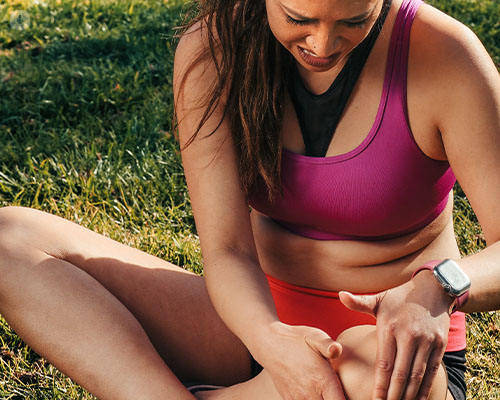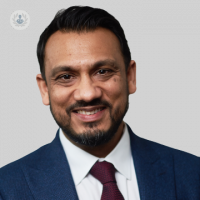All about ACL reconstruction surgery
Written by:The nature of an ACL tear can lead to complications if it goes untreated, particularly knee instability. Leading orthopaedic knee surgeon Mr Saket Tibrewal discusses the ins and outs of ACL reconstruction in this comprehensive article.

What is ACL reconstruction?
Anterior cruciate ligament (ACL) reconstruction is a surgical procedure to replace a torn or damaged ACL in your knee. It’s replaced with a tissue graft that’s most commonly obtained from your own body (autograft). In rare cases, it’s taken from a deceased donor (allograft).
The most common autografts are the hamstring tendons, which are the tendons located at the back of the thigh. The quadriceps tendon located above the kneecap, or the patellar tendon, which is the tendon of the kneecap, are utilised in some instances. Tendons are cords of strong fibrous tissue in the body that connect muscles to bones. Ligaments are tough bands of tissue, and they connect one bone to another.
ACL tears or injuries commonly occur during sports activities that involve:
- pivoting;
- cutting, and;
turning movements as in:
- football;
- soccer;
- skiing;
- tennis, and;
- basketball
Anatomy of the ACL
The ACL is one of the knee’s major stabilising ligaments. It’s a strong rope-like structure that’s located in the centre of the knee. It runs from the femur (thighbone) to the tibia, or shinbone.
It’s one of the four major knee ligaments that connects the femur to the tibia and helps stabilise your knee joint. The ACL prevents excessive forward movement of the tibia in relation to the femur. It also limits rotational knee movements.
When this ligament tears, it doesn’t heal on its own, unfortunately. This often leads to the feeling of instability in the knee, requiring reconstruction to correct the abnormality.
Who might benefit from ACL reconstruction?
Surgical reconstruction may be considered for any patient with an ACL tear which brings persistent knee instability.
An ACL tear is a sports-related injury, and it occurs when the knee is forcefully twisted or hyper-extended.
They usually occur with an abrupt directional change where the foot is fixed to the ground or when the deceleration force crosses the knee. The following can also result in injury to the ACL.
- Changing direction rapidly;
- stopping suddenly;
- slowing down suddenly while running;
- landing from a jump incorrectly, and;
- direct contact or collision, such as a football tackle.
How do you prepare for ACL reconstruction?
Preparation for ACL reconstruction surgery in general will involve the following steps:
Taking medical history and physical examination
These are performed to check for any medical issues that may need to be addressed before surgery.
Reducing risk through blood work and imaging
Depending on your medical and social history, as well as age, you may be required to undergo tests such as blood work and imaging. This is to assist in the detection any abnormalities which could compromise the safety of the procedure.
You’ll be asked if you’re allergic to:
- medications;
- anaesthesia, or;
- latex
You should inform your doctor if you have any conditions such as heart or lung disease, or are taking any medications or supplements.
You may be required to stop taking certain medications for a week or two. These include:
- blood thinners;
- anti-inflammatories;
- aspirin, or other supplements.
You shouldn’t consume any solids or liquids for at least six hours before the procedure.
We advise that you should arrange to be driven you home after surgery.
After the pros and cons of the surgery have been explained, you’ll be required to a sign an informed consent form.
What happens in an ACL reconstruction?
ACL reconstruction surgery is usually performed under general anaesthesia, and is done by using a minimally invasive arthroscopic technique. The procedure generally involves the following steps:
- The surgeon will make two to three small incisions, or cuts, around the knee. Each one is about 1/4-inch-long.
- An arthroscope is inserted into the knee joint through one of the incisions. It’s a thin tubular instrument with a camera, light, and a magnifying lens attached. It’s connected to an external monitor and enables the surgeon to see inside the knee joint.
- A sterile solution is pumped into the joint, along with the arthroscope, to expand it. This allows the surgeon to have a clear view and space to work inside the joint.
- Miniature surgical instruments are passed through the other incisions and the torn ACL is removed. The pathway is prepared for the new ACL tendon graft.
- The surgeon makes an incision over the knee or hamstring area. They then take out a part of the patellar, hamstring, or quadriceps tendon to prepare the new ACL
- Small holes are drilled into the femur and tibia where these bones come together at the knee joint. These holes form tunnels in your bone in order to accept the new graft.
- The graft is pulled through the pre-drilled holes in the femur and tibia. It’s then fixed into the bones with screws or suture anchors.
- After satisfactory reconstruction is confirmed, the scope and the instruments are withdrawn. The incisions are sutured and bandaged.
What happens after ACL reconstruction surgery?
Generally, postoperative care instructions and recovery after ACL reconstruction surgery will involve the following:
- You’ll be transferred to the recovery area where your nurse will closely observe you for any allergic or anaesthetic reactions. They will also monitor your vital signs as you recover.
- You may experience pain, swelling, and discomfort in the knee area. Pain and anti-inflammatory medications are provided when required, in order to keep you comfortable.
- It’s advised to keep your leg elevated while resting. This is to prevent swelling and pain.
- You’ll be given assistive devices like crutches, with instructions on weight-bearing. You’ll also be encouraged to walk with assistance as frequently as possible. This is to prevent blood clots.
- Instructions on surgical site care and bathing to keep the wound clean and dry, will be provided.
- An individualised physical therapy protocol to help strengthen the knee muscles and optimise knee function will be created and implemented.
- Full recovery and a return to contact/competitive sports usually takes around 12 months.
- You should be allowed to return to work at about 2 to 6 weeks, dependent upon your profession. If you have a physically demanding job, you may require a longer recovery period.
- Periodic follow-up appointments will be scheduled to monitor your progress.
What are the risks and complications of the procedure?
ACL reconstruction surgery is a relatively safe procedure. However, some risks and complications may occur, as with any surgery, such as the following:
- Infection
- Bleeding
- Knee pain and weakness
- Adverse reactions to anaesthesia
- A blood clot or deep vein thrombosis
- Damage to adjacent soft tissue structures
- Decreased range of motion or stiffness
- Re-rupture of the graft
- Non-healing of the ligament
If you’re considering ACL reconstruction surgery, arrange a consultation with Mr Tibrewal via his Top Doctors profile.


